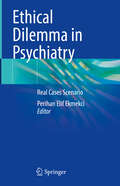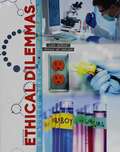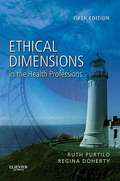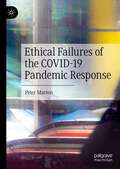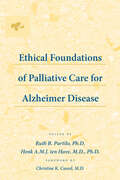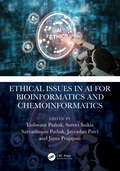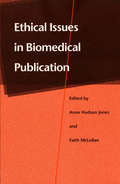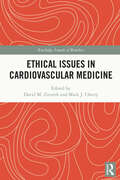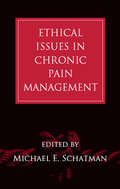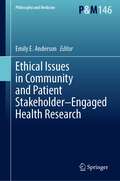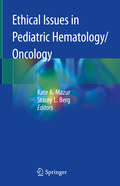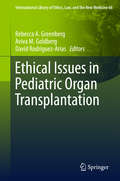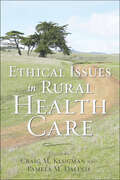- Table View
- List View
Ethical Deliberation in Multiprofessional Health Care Teams
by Hubert Doucet Jean-Marc Larouche Kenneth R. MelchinThis study analyzes both pragmatic and theoretical perspectives of ethical deliberation, as well as the professional and philosophical backgrounds for the ethical deliberation of social workers, nurses and doctors working in the field of chronic illness. In doing so, this volume expands the scope of current research through an analysis of the process and its dynamics.
Ethical Dilemma in Psychiatry: Real Cases Scenario
by Perihan Elif EkmekciPsychiatry is a field that differs from other fields of medical practice in terms of its ethical problems and ethical dilemmas it encounters. The physicians who specialize in the field of psychiatry or health professionals who work in mental health services should be equipped to recognize these ethical problems, to deal with them in the right ethical frameworks and to offer practical and appropriate solutions in their clinical practice. The work compiles extensive experiences from Medical Faculty of Ankara University, Turkey. The book aims to give a comprehensive understanding about the particular ethical problems and dilemmas in psychiatry and provide tools and methods to approach them in an ethically appropriate way.
Ethical Dilemmas for Critically Ill Babies
by Eduard Verhagen Annie JanvierMost neonates who now survive intensive care would have died 50 years ago, and "nature" would have decided the outcomes, making ethical discussions about initiating or withholding resuscitation irrelevant. Medical developments in neonatology have changed the way we respond to diseases of neonates, to their illness, and to their parents. Not only as physicians, but also as a society. Decisions on when to start, withhold, or withdraw life-saving interventions in critically ill neonates are among the most difficult decisions in pediatric practice. These decisions are fraught with ethical dilemmas, for example deciding whether withholding intensive care -leading to death- is superior to uncertain survival with a risk of disability and the additional burden of intensive care. This book covers important ethical questions that arise in neonatal intensive care units. Questions such as, whether to intervene medically and whether we are good at predicting the outcome of fragile neonates; whether a medical intervention should be withheld or withdrawn, and who should be primarily responsible for these decisions and how?
Ethical Dilemmas in Allied Health
by Janine M IdziakOver the past several decades, health care ethics has developed and flourished as an academic discipline. The field now includes a standard set of topics. Issues such as abortion, assisted reproduction, terminating life-sustaining treatment, euthanasia and physician aid-in-dying, confidentiality, and the allocation of scarce medical resources are commonly covered in textbooks on health care ethics. However, the perspective assumed in these textbooks may be limited in com¬parison with the actual range of health care services and types of health care professionals. Case studies on ethical dilemmas typically focus on physicians and nurses in a hospital setting. This textbook, on the other hand, approaches the standard problems of health care ethics from the perspective of the allied health fields. Case studies always involve allied health professionals, giving recognition to them as an integral part of the care giving team.
Ethical Dilemmas in Emergency Medicine
by Marco, Catherine and Schears, Raquel Catherine Marco Raquel SchearsThe emergency department is a place of challenging ethical dilemmas and little time and resources to solve them. Ethical Dilemmas in Emergency Medicine provides invaluable information, perspectives, and solutions to common ethical dilemmas in emergency medicine. It addresses important topics seen in the emergency department, including medicolegal issues, triage, privacy and confidentiality, social media, difficult patients, minors, research, patient safety, disasters, suicide, and end of life issues. The accompanying educational modules provide a unique educational opportunity for resident and staff education on ethical issues in emergency medicine. Featuring twenty-three case-based discussions of ethical dilemmas in emergency medicine along with numerous multimedia resources, including media presentations, case based discussions, and multiple choice questions, this book is an invaluable resource for residents in training as well as practicing physicians.
Ethical Dilemmas in Prenatal Diagnosis
by Elisabeth Hildt Tamara FischmannTechnological developments in the life sciences confront us with new facets of a Faustian seduction. Are we "playing God" more and more, as claimed by critical authors of modernity? Achievements in genetic research produce ethical dilemmas which need to be the subject of reflection and debate in modern societies. Denial of ambivalences that ethical dilemmas arouse constitutes a threat to societies as well as to individuals. The book presents a compilation of some of the results of the interdisciplinary European study "Ethical Dilemmas Due to Prenatal and Genetic Diagnostics" (EDIG), which investigated some of these dilemmas in detail in a field which is particularly challenging: prenatal diagnosis. When results from prenatal diagnosis show fetal abnormalities, women and their partners are confronted with ethical dilemmas regarding: the right to know and the right not to know; decision-making about the remainder of the pregnancy and the desire for a healthy child; responsibility for the unborn child, for its well-being and possible suffering; life and death. This book provides answers from an ethical, psychoanalytical and medical viewpoint.
Ethical Dimensions in the Health Professions
by Ruth B. Purtilo Regina F. DohertyIdeal for all health care professionals, Ethical Dimensions in the Health Professions, 5th Edition provides a solid foundation in basic ethical theory, the terms and concepts of ethics, and current ethical issues. Expert authors Ruth Purtilo and Regina Doherty outline a unique 6-step decision-making process as a guide to making effective choices that lead to a professional and caring response to patients. They also suggest practical approaches to commonly encountered clinical issues such as confidentiality, informed consent, information sharing, and end-of-life care. With this book, you will develop the skills you need to recognize, understand, and resolve ethical problems.
Ethical Failures of the COVID-19 Pandemic Response
by Péter MartonThis book draws attention to the non-biological—political, economic, societal and cultural—variables shaping both the emergence and persistence of the COVID-19 pandemic and the global response to it, with a particular focus on political decisionmakers’ role in the domestic and international politics surrounding the process of the pandemic. The book identifies the strategic and underlying ethical failures of decision making, using a process-tracing approach to reconstruct considerations, decisions and actions by key leaders—interested in thus weaving a global narrative of the response. The author highlights key speech acts, and interprets the causal implications embedded in a chronological and contextualised appraisal of events, statements and public health measures. The book further discusses the normative ethics of pandemic response, and presents lessons drawn from the present experience. It also offers a normative analysis taking into consideration pre-pandemic guidelines for response, including in the literature of public health ethics and pandemic preparedness plans.
Ethical Foundations of Palliative Care for Alzheimer Disease
by Ruth B. Purtilo Henk A.M.J. ten HaveAlzheimer disease afflicts more than twelve million people worldwide, and its incidence is increasing at a staggering rate. People with the disorder are living longer than have those in previous generations, and they require interventions for quality-of-life issues associated with palliative care. However, the symptoms of Alzheimer disease often fail to place such persons into settings where palliative care resources are available to them. Indeed, clinicians and other caregivers may be unsure about what constitutes effective palliation in these cases. At the same time, the ethical issues involved in providing end-of-life care to persons with Alzheimer disease remain on the margins of mainstream bioethics.In Ethical Foundations of Palliative Care for Alzheimer Disease, leading ethicists and clinicians from the United States and Europe explore ethical and scientific concerns about the diagnosis and prognosis of Alzheimer disease, challenges arising from applying palliative procedures to its symptoms, key philosophical and theological concepts central to our understanding of the disease and to end-of-life decisions, and the changing patterns of relevant medical, social, and economic policies. Cross-cultural, multidisciplinary, and state-of-the-art, this volume is a unique and important resource for bioethicists, clinicians, and policy makers everywhere.Contributors: David A. Bennahum, M.D., University of New Mexico; Pierre Boitte, Ph.D., Catholic University of Lille, France; Roger A. Brumback, M.D., Creighton University Medical Center; Wim J. M. Dekkers, M.D., Ph.D., University Medical Centre Nijmegen, The Netherlands; Elizabeth Furlong, R.N., Ph.D., J.D., Creighton University Medical Center; Eugenijus Gefenas, M.D., Ph.D., Vilnius University, Lithuania; Bert Gordijn, Ph.D., University Medical Centre Nijmegen, The Netherlands; Amy M. Haddad, R.N., Ph.D., Creighton University Medical Center; Søren Holm, M.D., Ph.D., Dr.Med.Sci., University of Manchester; Franz J. Illhardt, D.D., Ph.D., Freiburg University; Rien Janssens, Ph.D., University Medical Centre Nijmegen, The Netherlands; Givi Javashvili, M.D., Ph.D., State Medical Academy of Georgia, Tbilisi; Judith Lee Kissell, Ph.D., Creighton University Medical Center; Gunilla Nordenram, D.D.S., Ph.D., Karolinska Institute, Stockholm; Richard L. O'Brien, M.D., Creighton University Medical Center; Marcel G. M. Olde Rikkert, M.D., Ph.D., University Medical Centre Nijmegen, The Netherlands; Winifred J. Ellenchild Pinch, R.N., Ed.D., Creighton University Medical Center; Patricio F. Reyes, M.D., Creighton University Medical Center; Anne-Sophie Rigaud, M.D., Ph.D., Hôpital Broca, Paris; Linda S. Scheirton, Ph.D., Creighton University Medical Center; Jos V. M. Welie, M.Med.S., J.D., Ph.D., Creighton University Medical Center.
Ethical Imperialism: Institutional Review Boards and the Social Sciences, 1965–2009
by Zachary M. SchragA powerful indictment of the IRB regime.University researchers in the United States seeking to observe, survey, or interview people are required first to complete ethical training courses and to submit their proposals to an institutional review board (IRB). Under current rules, IRBs have the power to deny funding, degrees, or promotion if their recommended modifications to scholars’ proposals are not followed. This volume explains how this system of regulation arose and discusses its chilling effects on research in the social sciences and humanities.Zachary M. Schrag draws on original research and interviews with the key shapers of the institutional review board regime to raise important points about the effect of the IRB process on scholarship. He explores the origins and the application of these regulations and analyzes how the rules—initially crafted to protect the health and privacy of the human subjects of medical experiments—can limit even casual scholarly interactions such as a humanist interviewing a poet about his or her writing. In assessing the issue, Schrag argues that biomedical researchers and bioethicists repeatedly excluded social scientists from rule making and ignored the existing ethical traditions in nonmedical fields. Ultimately, he contends, IRBs not only threaten to polarize medical and social scientists, they also create an atmosphere wherein certain types of academics can impede and even silence others. The first work to document the troubled emergence of today's system of regulating scholarly research, Ethical Imperialism illuminates the problems caused by simple, universal rule making in academic and professional research. This short, smart analysis will engage scholars across academia.
Ethical Innovation for Global Health: Pandemic, Democracy and Ethics in Research
by Chieko Kurihara Dirceu Greco Ames DhaiThis volume captures the recent changes and evolution in ethics in research involving humans and provides future directions to achieve alternative drug development strategies for equitable global health. It presents ethical considerations in current day clinical trials and new trends of ethics in research. It also describes the historical context, illustrates the process in alternative paradigms to achieve democracy after World War II, how the framework of ethics in research was established in different regions, and policies implemented to protect research participants from the exploitation of new drug development. The book is organized into three themed parts: relevant constructions from Brazil, South Africa, Taiwan, South Korea, and Japan; historical and international perspectives of principles of ethics in research; and alternative frameworks of clinical development and innovation. Ethical Innovation for Global Health: Pandemic, Democracy and Ethics in Research is an informative resource for academic researchers, the global pharmaceutical industry, regulators, civil society and other role players involved in global health. It is contributed to by leaders in global policy development in research ethics, and experts in drug development activities with its trajectory being global health. The COVID-19 pandemic, as a global disaster, necessitated not only socio-economic but also cultural transformation. While effective vaccines were developed under a successful new methodology, there remains inequity of distribution of these vaccines globally. The book re-engages with the notion of the primacy of distributing results of scientific innovation to those who most require the benefits.
Ethical Issues in AI for Bioinformatics and Chemoinformatics
by Yashwant Pathak, Surovi Saikia, Sarvadaman Pathak, Jayvadan Patel and Jigna PrajapatiThis unique volume presents AI in relation to ethical points of view in handling big data sets. Issues such as algorithmic biases, discrimination for specific patterns and privacy breaches may sometimes be skewed to affect research results so that certain fields to appear more appealing to funding agencies. The discussion on the ethics of AI is highly complex due to the involvement of many international stakeholders such as the UN, OECD, parliaments, industry groups, professional bodies, and individual companies. The issue of reliability is addressed including the emergence of synthetic life, 5G networks, intermingling of human artificial intelligence, nano-robots and cyber security tools. Features Discusses artificial intelligence and ethics, the challenges and opportunities Presents the issue of reliability in the emergence of synthetic life, 5G networks, intermingling of human artificial intelligence, nano-robots, and cyber security tools Ethical responsibility and reasoning for using AI in Big Data Addresses practicing medicine and ethical issues when applying artificial intelligence
Ethical Issues in Anesthesiology and Surgery
by Barbara G. JerichoEach chapter includes an ethical challenge presented as a clinical case scenario that readers may relate to in their daily practice of anesthesiology and surgery. The ethical issues surrounding each chapter's content are examined in an easily understandable manner for the specific target audience to improve the understanding and management of ethical dilemmas in patient care. Informed consent issues for the adult and pediatric patient, perioperative considerations of do-not-resuscitate orders, ethical issues of drug shortages, transplantation ethics, surgical care of patients and futility, conscientious objection, informed consent and disclosure of surgeon experience, and research and publication ethics are included and based on the experience of the Editor and the roster of contributors.
Ethical Issues in Biomedical Publication
by Anne Hudson Jones Faith McLellanWhen the editors of two of the most prominent medical journals in the world—the New England Journal of Medicine and the Journal of the American Medical Association (JAMA)—were fired in the same year, under circumstances that ranged from acrimonious to politically sensational, media attention again focused on biomedical publication. The controversy highlighted yet another ethical dimension of scientific research and its publication, topics that have generated intense scrutiny in recent years. As research funding has become scarcer and competition fiercer, with links between scientific discovery and commercial applications increasingly tighter and more lucrative, allegations of misconduct have also increased. Universities and research institutions, notably the NIH, have created offices of scientific integrity and mandated educational programs to investigate such allegations and to train researchers in the highest standards of sound, ethical scientific research.Focusing on publication ethics as an essential aspect of responsible scientific conduct, Ethical Issues in Biomedical Publication examines a variety of troublesome issues, including authorship, peer review, repetitive publication, conflict of interest, and electronic publishing. The contributors include the editors of distinguished biomedical journals (among them, past or present editors of Academic Medicine, Annals of Internal Medicine, British Medical Journal, JAMA, and the Lancet), humanities scholars, scientists, lawyers, and a university administrator. Chapters address specific ethical issues and offer recommendations for preventing or solving problems associated with them. The result is a book that will serve as a standard reference for biomedical researchers, authors, editors, and teachers of research ethics."Educators, administrators, scientists, editors, and students should all welcome this comprehensive new book. Anne Hudson Jones and Faith McLellan have gathered a veritable who's who in the field of publication ethics for biomedical research. All those with a stake in biomedical research will surely want this volume on their bookshelf."—from the Foreword by Jordan J. Cohen, M.D., President, Association of American Medical Colleges
Ethical Issues in Cardiovascular Medicine (Routledge Annals of Bioethics)
by Mark J. Cherry David M. ZientekThis book provides an exploration of the ethics of cardiology practice. It provides a variety of frameworks for analyzing ethical issues that arise in cardiovascular medicine. Cardiovascular medicine—the diagnosis and treatment of congenital and acquired diseases of the heart, major arteries, and veins—has seen rapid change in diagnosis, treatment, and the organization of practice in the last half of the twentieth and the beginning of the twenty first century. The complexity of these developments has resulted in increasing subspecialization, and many practitioners are challenged to stay abreast with the latest developments in cardiology. These changes also bring with them various ethical challenges. The chapters in this volume are divided by five broad areas of practice: beginning-of-life, end-of-life, transplantation and allocation of expensive or scarce resources, professionalism, and research. The case-based approach presented across the volume provides a perspective that will allow readers to reason through current and future ethical issues as they arise in this rapidly changing field. Ethical Issues in Cardiovascular Medicine will be of interest to researchers working in bioethics, clinical ethics, and the philosophy of medicine, as well as practicing physicians, nurses, and students who work in cardiovascular medicine.
Ethical Issues in Child Abuse Research
by Alex V. Levin Katherine Guttmann Michelle ShouldiceThis book serves as a comprehensive resource for researchers and regulatory bodies working to establish sound evidence bases through research for the care of children and families affected by abuse. Issues such as consent, anonymous research, and how to interface with the legal system in terms of disclosure and sharing of results are discussed in depth. Ethical Issues in Child Abuse Research also provides insights into questions of ethics in animal research, perpetrator and retrospective research, and balances the necessity of collecting this valuable information while protecting vulnerable populations, and respecting their privacy while interacting in a complex legal system. With input from many leaders in child abuse research, this book fills a critical need, providing readers with a pathway to apply these principles of ethics to their own research in this challenging field.
Ethical Issues in Chronic Pain Management (Pain Management Ser. #Vol. 1)
by Michael E. SchatmanSpecifically designed to address the needs of all specialists involved in the care of chronic pain patients, this source clarifies the ethical and legal issues associated with the diagnosis, assessment, and care of patients suffering from long-term pain. Divided into five comprehensive sections, this source covers a variety of topics to help the ch
Ethical Issues in Clinical Forensic Psychiatry
by Artemis IgoumenouThis work explores and discusses the ethical dilemmas clinicians face in everyday forensic psychiatry practice. We discuss and reflect on ethical issues involving treatment decisions such as antipsychotic polypharmacy, high doses antipsychotics and prescribing anti-libidinal medications. Ethical issues surrounding the use of technology for the management of mentally disordered offenders are explored in depth. The use of the polygraph test, a controversial method of truth facilitation for sex offenders, is discussed. Similarly, we discuss the use of "tagging" for serious offenders that despite being used in the United States of America for a while it has been heavily criticized and opposed. Tagging is gradually being introduced in the UK and other European countries, making consideration of the ethical issues and dilemmas surrounding its use both timely and necessary. This work is a valuable guide for clinicians working in forensic psychiatry settings, particularly when faced with ethical dilemmas concerning decisions around interventions.
Ethical Issues in Community and Patient Stakeholder–Engaged Health Research (Philosophy and Medicine #146)
by Emily E. AndersonThis book provides in-depth analyses of a wide range of topics surrounding ethical issues in community and patient stakeholder–engaged health research, and highlights where consensus exists, is emerging, or remains elusive. Topics in this book cover the history of stakeholder engagement in health research; how codes of ethics and regulations have (or have not) addressed stakeholder engagement; how to promote equitable collaboration; the ethical perspectives of different stakeholders; and the unique challenges posed by stakeholder- engaged research to the protection of human research participants and the research ethics review process. The book includes discussion of unique issues that arise in stakeholder engagement relevant to different populations, settings, and research designs. This book is relevant for anyone with a role or interest in stakeholder-engaged research, including patient and community research partners; academic researchers; research ethics scholars and educators; and funders.
Ethical Issues in Dementia Care: Making Difficult Decisions
by Julian C. Hughes Clive BaldwinBradford Dementia Group Good Practice Guides There are always difficult day to day decisions to be faced when caring for a person with dementia - from knowing how to deal with wandering to end of life decisions. Many of these decisions are underpinned by value judgments about right and wrong and reflect a particular view of dementia. This book considers these ethical decisions in the context of relationships, treatment, safety and quality of life, offering practical guidance and advice. It draws on the experiences of family carers as well as on existing research and emphasizes the importance of empathy and the need to acknowledge different perspectives in order to reach the best decision for the person with dementia. In particular the authors discuss the way that decision makers are themselves changed by the decisions they make, and the impact of this on the decision-making process. This book should be read by all those who work caring for people with dementia.
Ethical Issues in Forensic Psychiatry
by Robert L. SadoffEthical medical practice and treatment in psychiatry are based on the concept of first do no harm. However, this cannot, and does not, apply to forensic cases where there is no doctor-patient relationship and the forensic psychiatrist may indeed cause harm to the examinee. In this book, Robert Sadoff analyzes the ethical issues affecting forensic psychiatric practice, especially those promulgated by the American Academy of Psychiatry and the Law. Within those guidelines, he looks at individual bias, vulnerability of the examinee, and potential harm to the mental health professional. The book discusses each of the procedures of the forensic expert separately with respect to minimizing harm. It has been written with an international audience in mind and features chapters reviewing the European and UK perspectives, by Emanuele Valenti and John Baird, respectively.Robert Sadoff addresses the long-term harm that can be either avoided or minimized through careful planning and application of ethical principles. He is not advocating that the harm can be totally eliminated, because that is impossible in the adversarial system in which forensic psychiatrists work. However, there are means by which harm may be minimized if care is taken during the assessment, the report writing, and the testimony phase of the proceedings. The book develops the scope of forensic psychiatry from the standpoint of administrative, civil and criminal cases. It presents the practical issues involved in conducting forensic psychiatric assessments under various conditions plus special considerations, such as bias, minimizing harm, developing a therapeutic approach, and elaborating on various vulnerable individuals who are frequently examined in forensic cases. These include juveniles, mentally retarded, autistic, sexual assault victims, the elderly, the organically damaged, the psychotic, and mentally disabled prisoners. Immigrants are covered in a chapter by Solange Margery Bertoglia. The ethical issues in conducting forensic psychiatric examinations and presenting psychiatric testimony in court are examined and discussed. Cases illustrating the difficulties involved punctuate the presentation. The book closes with a fascinating account of the legal perspective by Donna Vanderpool.In summary, this book illustrates the ethical and practical issues that affect forensic psychiatric practice. The question is not what we do, but how we do it, and which standards, ethical guidelines and personal values contribute to the total picture. Despite the fact that we cannot always adhere to the doctrine of "primum non nocere," we can minimize the harm caused inherently by the adversarial system in which we participate.Praise for Ethical Issues in Forensic Psychiatry"One of the founding giants of the forensic psychiatric field has written here far more than a "mere" ethics textbook. Instead, this compendium serves multiple purposes: it is a valuable primer on forensic techniques of examination and testimony, a model of best forensic practices, and an instruction on the most appropriately civilized way in which to conduct oneself as a forensic psychiatrist.The success of these multiple accomplishments clearly derives from characteristics of the author. In both sage advice to practitioners and in many revealing case examples, Dr. Sadoff displays the tact, good manners and sensitivity of a consummate gentleman - a term not always associated with the hurly-burly of courtroom work. The book's primary focus on avoiding harm to all the parties involved in the work places it on the moral high ground of the legal system in which participating clinicians must find a place."Thomas G. Gutheil, MD, Professor of Psychiatry and Co-Founder, Program in Psychiatry and the Law, Beth Israel Deaconess Medical Center, Harvard Medical School
Ethical Issues in Pediatric Hematology/Oncology
by Kate A. Mazur Stacey L. BergThis book identifies the various ethical challenges that arise in pediatric hematology/oncology and provides the necessary tools to overcome these challenges. Aiming to expand upon and strengthen providers’ knowledge and experience in pediatric health care ethical issues, the text positions providers to be beneficial resources to faculty, staff, patients, and families within their institution. It presents a multidisciplinary approach to sound ethical practices that is necessary to effectively care for these patients and their families. The book reviews the principles of ethical decision-making, the unique difficulties in using children as research subjects, common ethical conundrums involved in providing end-of-life care, and general moralities of professional practice. Written by experts in their fields, Ethical Issues in Pediatric Hematology/Oncology is an innovative and valuable resource for clinicians, practitioners, and trainees who work in the field of pediatric hematology/oncology.
Ethical Issues in Pediatric Organ Transplantation
by Rebecca A. Greenberg Aviva M. Goldberg David Rodríguez-AriasThis book offers a theoretical and practical overview of the specific ethical and legal issues in pediatric organ transplantation. Written by a team of leading experts, Ethical Issues in Pediatric Organ Transplantation addresses those difficult ethical questions concerning clinical, organizational, legal and policy issues including donor, recipient and allocation issues. Challenging topics, including children as donors, donation after cardiac death, misattributed paternity, familial conflicts of interest, developmental disability as a listing criteria, small bowel transplant, and considerations in navigating the media are discussed. It serves as a fundamental handbook and resource for pediatricians, transplant health care professionals, trainees, graduate students, scholars, practitioners of bioethics and health policy makers.
Ethical Issues in Prison Psychiatry
by Birgit Völlm David N. Weisstub Norbert KonradRecent surveys demonstrate a high and possibly increasing prevalence of mental disorders in prisoners. They have an increased risk of suffering from a mental disorder that transcends countries and diagnoses. Ethical dilemmas in prison psychiatry arise from resource allocation and include issues of patient choice and autonomy in an inherently coercive environment. Ethical conflicts may arise from the dual role of forensic psychiatrists giving raise to tensions between patient care/protection of the public.This book describes models and ethical issues of psychiatric healthcare in prison in several countries. Relevant issues are: the professional medical role of a psychiatrist and/or psychotherapist working in prison, the involvement of psychiatrists in disciplinary or coercive measures; consent to treatment, the use of coercion in forcing a prisoner to undergo treatment, hunger strike, confidentiality. The book ends with consensus guidelines concerning good practice in Prison Psychiatry.
Ethical Issues in Rural Health Care (Bioethics)
by Craig M. KlugmanKlugman and Dalinis initiate a much-needed conversation about the ethical and policy concerns facing health care providers in the rural United States.This volume initiates a much-needed conversation about the ethical and policy concerns facing health care providers in the rural United States. Although 21 percent of the population lives in rural areas, only 11 percent of physicians practice there. What challenges do health care workers face in remote locations? What are the differences between rural and urban health care practices? What particular ethical issues arise in treating residents of small communities? Craig M. Klugman and Pamela M. Dalinis gather philosophers, lawyers, physicians, nurses, and researchers to discuss these and other questions, offering a multidisciplinary overview of rural health care in the United States. Rural practitioners often practice within small, tight-knit communities, socializing with their patients outside the examination room. The residents are more likely to have limited finances and to lack health insurance. Physicians may have insufficient resources to treat their patients, who often have to travel great distances to see a doctor.The first part of the book analyzes the differences between rural and urban cultures and discusses the difficulties in treating patients in rural settings. The second part features the personal narratives of rural health care providers, who share their experiences and insights. The last part introduces unique ethical challenges facing rural health care providers and proposes innovative solutions to those problems. This volume is a useful resource for bioethicists, members of rural bioethics committees and networks, policy makers, teachers of health care providers, and rural practitioners themselves.

